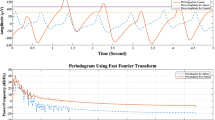Abstract
Obstructive sleep apnea is a sleep disorder which may lead to various results. While some studies used real-time systems, there are also numerous studies which focus on diagnosing Obstructive Sleep Apnea via signals obtained by polysomnography from apnea patients who spend the night in sleep laboratory. The mean, frequency and power of signals obtained from patients are frequently used. Obstructive Sleep Apnea of 74 patients were scored in this study. A visual-scoring based algorithm and a morphological filter via Artificial Neural Networks were used in order to diagnose Obstructive Sleep Apnea. After total accuracy of scoring was calculated via both methods, it was compared with visual scoring performed by the doctor. The algorithm used in the diagnosis of obstructive sleep apnea reached an average accuracy of 88.33 %, while Artificial Neural Networks and morphological filter method reached a success of 87.28 %. Scoring success was analyzed after it was grouped based on apnea/hypopnea. It is considered that both methods enable doctors to reduce time and costs in the diagnosis of Obstructive Sleep Apnea as well as ease of use.






Similar content being viewed by others
References
Köktürk, O, Scoring of Sleep Recordings, Turkish Respiratory Society, J. Res. 15:14–29, 2013.
Berry RB, Brooks R, Gamaldo CE, Harding SM, Lloyd RM, Marcus CL and Vaughn BV For the american academy of sleep medicine. The AASM manual for the scoring of sleep and associated events: rules, terminology and technical specifications, Version 2.1. www.aasmnet.org, Darien, Illinois: American Academy of Sleep Med.(2014)
Canosa, M.C., Pereiro, M.C.M.G., Pereira, E.H., Bonillo, V.M., Egana, M.M., and Hernando, H.V., An intelligent system for the detection and interpretation of sleep apneas. Expert Syst. Appl. 24:335–349, 2003.
Romero, O.F., Berdinas, B.G., Betanzos, A.A., and Bonillo, V.M., A new method for sleep apnea classification using wavelets and feedforward neural networks. Artif. Intell. Med. 34:65–76, 2005.
Marcos, J.V., Hornero, R., Álvarez, D., Campo, F., and Zamarrón, C., Assessment of four statistical pattern recognition techniques to assist in obstructive sleep apnoea diagnosis from nocturnal oximetry. Med. Eng. Phys. 31:971–978, 2009.
Tagluk, M.E., Akin, M., and Sezgin, N., Classıfıcation of sleep apnea by using wavelet transform and artificial. Expert Syst. Appl. 37:1600–1607, 2010.
Güneş, S., Polat, K., and Yosunkaya, Ş., Multi-class f-score feature selection approach to classification of obstructive. Expert Syst. Appl. 37:998–1004, 2010.
Babaeizadeh, S., Zhou, S.H., Pittman, S.D., and White, D.P., Electrocardiogram-derived respiration in screening of sleep-disordered breathing. J. Electrocardiol. 44:700–706, 2011.
Berdiñas, B.G., Pereira, E.H., and Barral, D.P., A mixture of experts for classifying sleep apneas. Expert Syst. Appl. 39:7084–7092, 2012.
Fakhr, S.M., Torbati, M.M., Hill, M., Simson, D., Bucks, R.S., Carrol, A., and Hill, C.M., Respiratory cycle related EEG changes: modified respiratory cycle segmentation. Biomed. Signal Process Control. 8:838–844, 2013.
Sezgin, N., EMG classication in obstructive sleep apnea syndrome and periodic limb movement syndrome patients by using wavelet packet transform and extreme learning machine. Turk. J. Electr. Eng. Comput. Sci. 23:873–884, 2015.
Papoulis, A.. Probability, random variables, and stochastic processes, McGraw-Hill International Editions (1991).
Serra, J., and Vincent, L., An overview of morphological filtering published in circuits, systems and. Signal Process. 11:47–108, 1992.
Jordan, T.J., Understanding medical information: a user’s guide to informatics and decision making. McGraw-Hill, New York, 2002.
Author information
Authors and Affiliations
Corresponding author
Additional information
This article is part of the Topical Collection on Systems-Level Quality Improvement.
Rights and permissions
About this article
Cite this article
Aydoğan, O., Öter, A., Güney, K. et al. Automatic Diagnosis of Obstructive Sleep Apnea/Hypopnea Events Using Respiratory Signals. J Med Syst 40, 274 (2016). https://doi.org/10.1007/s10916-016-0624-0
Received:
Accepted:
Published:
DOI: https://doi.org/10.1007/s10916-016-0624-0




